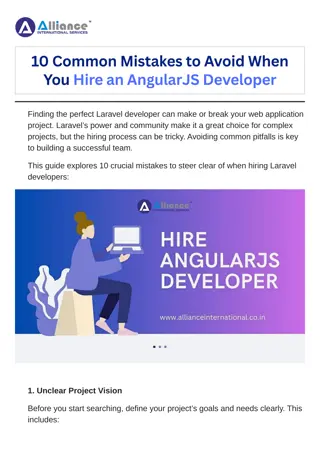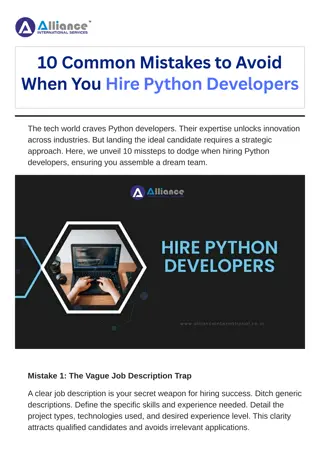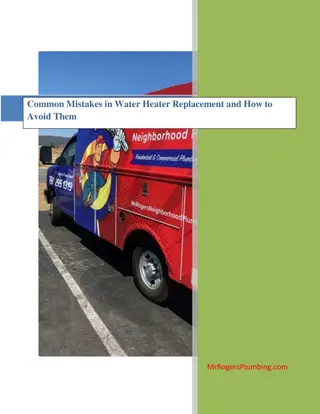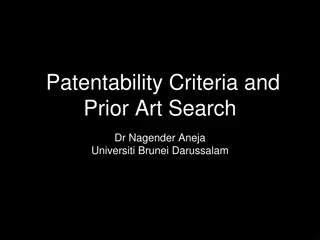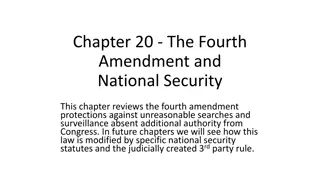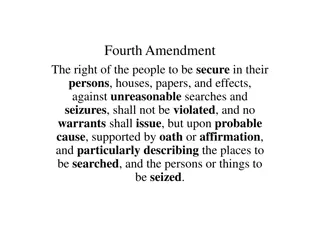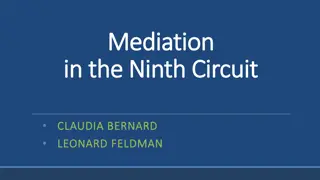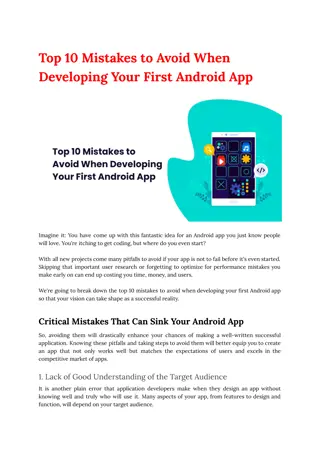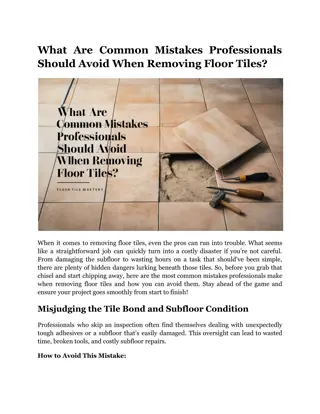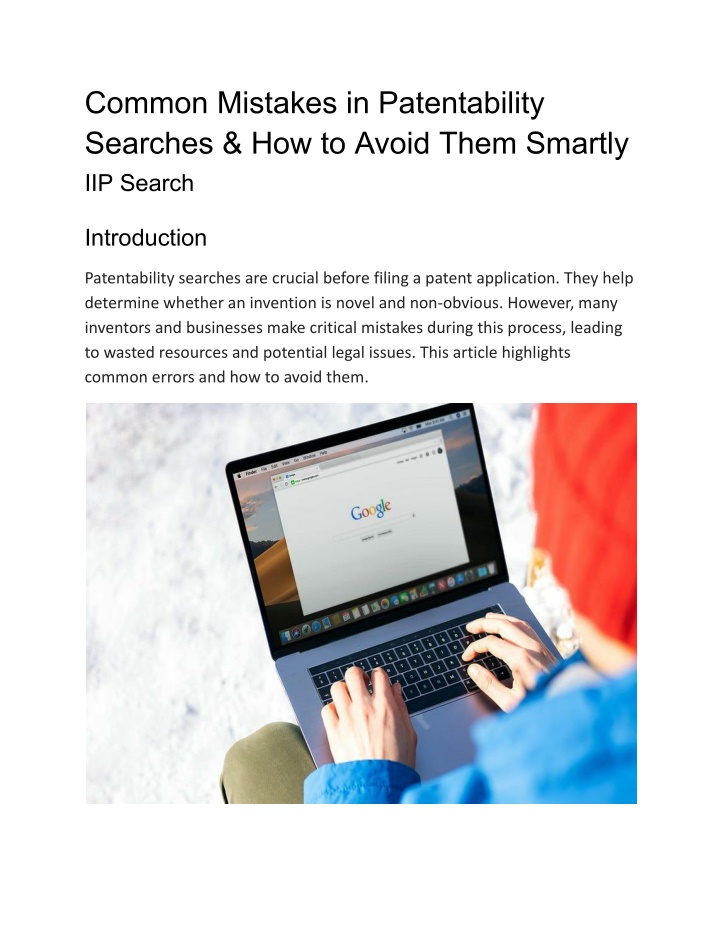
Common Mistakes in Patentability Searches & How to Avoid Them Smartly
Avoiding common mistakes in patentability searches is crucial for securing a strong patent. This blog highlights key errors, such as neglecting prior art, relying on free tools, using limited keywords, and overlooking international patents. Learn how
Download Presentation

Please find below an Image/Link to download the presentation.
The content on the website is provided AS IS for your information and personal use only. It may not be sold, licensed, or shared on other websites without obtaining consent from the author. If you encounter any issues during the download, it is possible that the publisher has removed the file from their server.
You are allowed to download the files provided on this website for personal or commercial use, subject to the condition that they are used lawfully. All files are the property of their respective owners.
The content on the website is provided AS IS for your information and personal use only. It may not be sold, licensed, or shared on other websites without obtaining consent from the author.
E N D
Presentation Transcript
Common Mistakes in Patentability Searches & How to Avoid Them Smartly IIP Search Introduction Patentability searches are crucial before filing a patent application. They help determine whether an invention is novel and non-obvious. However, many inventors and businesses make critical mistakes during this process, leading to wasted resources and potential legal issues. This article highlights common errors and how to avoid them.
1. Ignoring Prior Art Research One of the biggest mistakes in patentability searches is neglecting prior art. Many assume their idea is unique without thorough research. Prior art includes existing patents, publications, and publicly available knowledge. How to Avoid It: Conduct a comprehensive search of patent databases. Review non-patent literature, including research papers and industry reports. Use professional patent search tools and consult experts. 2. Relying Only on Free Search Tools Many inventors use free patent databases like Google Patents or the USPTO s search engine. While helpful, these tools have limitations, such as outdated records or incomplete data. How to Avoid It: Use professional databases like Derwent Innovation or PatBase. Work with a patent attorney or search professional for better accuracy. Cross-check results across multiple platforms. 3. Using Limited Search Keywords A narrow search using only a few keywords can miss relevant prior art. Patents often use technical jargon or unconventional terminology. How to Avoid It: Use synonyms, technical terms, and variations of keywords. Search in multiple languages and jurisdictions.
Apply Boolean search techniques for more precise results. 4. Overlooking International Patents Many inventors focus only on domestic patents, ignoring global filings. However, patents filed in other countries may still impact novelty and patentability. How to Avoid It: Search international databases like WIPO s PATENTSCOPE or the European Patent Office (EPO). Consider foreign patent laws that may affect your invention. Work with professionals experienced in global patent searches. 5. Misinterpreting Search Results Even when prior art is found, some fail to correctly analyze it. This can lead to overconfidence in patentability or unnecessary rejection risks. How to Avoid It: Compare the claims of prior patents with your invention. Seek expert opinions to understand relevance and risks. Document all findings properly for future reference. 6. Not Updating the Search Before Filing Patent landscapes constantly evolve, with new applications filed daily. A search conducted months earlier may have become outdated. How to Avoid It: Perform a final patent search before submitting your application. Monitor patent databases regularly for new filings.
Stay informed about industry trends and advancements. 7. Skipping Legal Consultation Many inventors attempt patent searches without professional help. While self-searching is possible, it often leads to missed details. How to Avoid It: Hire a patent attorney or patent search firm. Discuss findings with an expert to refine the application strategy. Ensure compliance with patent laws and regulations. 8. Failing to Analyze Competitor Patents Understanding competitor patents helps inventors gauge the competitive landscape and avoid infringement risks. Many neglect this crucial step. How to Avoid It: Research patents in your industry and analyze competitor filings. Identify trends in patent activity related to your field. Use patent landscape analysis to refine your innovation strategy. 9. Not Understanding Patent Classification Codes Patent classification codes categorize inventions based on technology. Searching without considering these codes may lead to incomplete results. How to Avoid It: Learn about the International Patent Classification (IPC) and Cooperative Patent Classification (CPC) systems. Use classification codes to refine search queries.
Seek guidance from professionals who understand patent classifications. 10. Overestimating the Strength of Your Patent Application Some inventors assume that their invention will automatically receive patent protection. However, strong prior art or weak claims can lead to rejections. How to Avoid It: Perform multiple iterations of the search process. Consult a patent attorney to draft strong and defensible claims. Consider alternative strategies like trade secrets if patents are not viable. 11. Not Considering Design Patents and Utility Models Many inventors focus solely on utility patents and overlook design patents or utility models, which might offer additional protection. How to Avoid It: Research all types of intellectual property protection options. Explore whether a design patent or utility model suits your invention. Combine different types of IP protection for a robust strategy. 12. Ignoring Expired or Abandoned Patents Expired or abandoned patents can be valuable sources of information, but many inventors disregard them.
How to Avoid It: Review expired patents to see if an invention is now free to use. Learn from abandoned patents to avoid common mistakes. Use expired patents to improve your innovation strategy. 13. Relying on Automated Search Reports Without Review AI and automated search tools are useful, but relying on them without a manual review can lead to missed details. How to Avoid It: Use automated tools as a starting point, not the final decision. Cross-check results with manual searches and expert analysis. Review findings in-depth before proceeding with the application. Conclusion Avoiding these common mistakes in patentability searches increases your chances of securing a strong patent. Thorough research, professional guidance, and proper search techniques are essential for a successful patent application. Taking these steps can save time, money, and legal complications. For a professional patentability search, visit IIP Search and ensure your invention stands the best chance of securing a patent!



